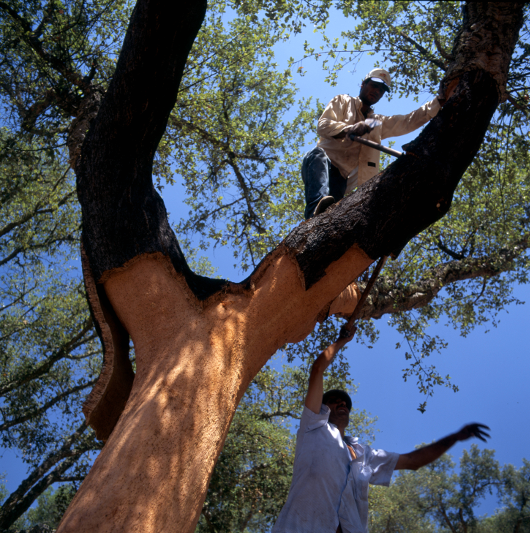Portugal: Message in a bottle ... from Cork Country
25.02.14
It’s the end of a long day; you kick off your shoes, fetch a couple of glasses and reach for your favourite bottle of claret. You lovingly draw the cork from the bottle, thrilled by that familiar squeaky ‘pop’ as your senses begin to tingle with anticipation!
You probably won’t be thinking about the cork at this point, but just to humour me, take a little time out and reflect on what is one of the natural world’s most amazing and sustainable non-timber forest products. It is impermeable to liquids and gasses, compressible, flexible, renewable and biodegradable. The cork oak tree demands neither pesticides nor fertilizers and the age- old harvesting practices are entirely environmentally friendly.

Cork harvesting (copyright APCOR)
But cork is under threat from the use of plastic stoppers and metal screw caps! So, consider this. Cork oak forests are magical places supporting many globally endangered species of birds, animals, insects, reptiles and plants. The Iberian lynx once roamed the cork oak forests and open scrubland of southern France and the Iberian Peninsula but this classic ‘flagship’ species is now the most critically threatened feline in the world due to habitat loss, hunting and lack of prey. If we lose this beautiful creature, it will be the first cat to become extinct since the sabre- toothed tiger!
Catching sight of an Iberian Imperial eagle, soaring high above the forests and mountain peaks of southern Spain is also a wonderful sight but sadly, now, a rare one as there are only 300-400 individuals remaining. Continued maintenance of cork oak forests is crucial to their survival and that of other breeding birds like the black vulture, short toed eagle and black stork. The short toed eagle makes huge platform nests high in the canopies of cork trees growing on mountainsides.Smaller birds, like robins, chaffinches, and song thrushes migrate to the cork forests from northern Europe, along with blackcaps from the UK. Shelter and support is also provided for red kite, black kite, kestrel, common crane, stock dove, turtle dove, barn owl, bee-eater, woodlark, crested tit, great grey shrike, woodchat shrike and European serin – a veritable birdwatcher’s paradise! In spring and summer, the shady forests are also home to a rich variety of butterflies and plants. Scientists have counted more than 60 species of plant in a single square metre of earth!
Slopes of the Atlas Mountains in North Africa were once covered in Cork forests but they have become so fragmented that both the Barbary deer and the Barbary macaque have become seriously threatened. I had my first encounter with a cork oak tree here many years ago in the beautiful Forest of Marmora on the outskirts of Rabat in Morocco. This forest contains more than half of Morocco’s cork trees and is not only a haven for migratory birds but provides a cool and tranquil refuge for city dwellers escaping the heat and noise of summer. Cork forests also provide a vital source of income for more than 100,000 people in some of the poorest parts of Europe and North Africa. If the commercial viability of cork lands is reduced because of the use of alternatives like metal and plastic, the vital balance between conservation of biodiversity and human activity and development will be lost. Cork woodlands also provide a home for livestock like the Iberian pig, producing high-value ham and another source of income from the forest. If you visit the little cork oak woodland in the Mediterranean biome at the Eden Project in Cornwall you will see representations of these pigs by artist, Heather Jansch. Her delightful cork and driftwood pigs snuffle about under the cork trees looking for acorns and demonstrate the links between managed woodland, food production and the conservation of biodiversity,
Cork forests also provide a vital source of income for more than 100,000 people in some of the poorest parts of Europe and North Africa. If the commercial viability of cork lands is reduced because of the use of alternatives like metal and plastic, the vital balance between conservation of biodiversity and human activity and development will be lost. Cork woodlands also provide a home for livestock like the Iberian pig, producing high-value ham and another source of income from the forest. If you visit the little cork oak woodland in the Mediterranean biome at the Eden Project in Cornwall you will see representations of these pigs by artist, Heather Jansch. Her delightful cork and driftwood pigs snuffle about under the cork trees looking for acorns and demonstrate the links between managed woodland, food production and the conservation of biodiversity,
Without the marriage between the bark of the cork oak tree and a bottle tall enough to lie on its side, fine matured wine could never have been discovered. Cork has unique properties that make it an ideal closure for wine. The cork stopper can be traced back as far as Ancient Egypt and Greece but it wasn’t widely used until its reinvention in the 17th century by the French Benedictine monk, Dom Pierre Perignon who used it in receptacles for sparkling wine. From that time on the wine industry never looked back and the cork stopper soon came into general use.
Wine corks are the most profitable of the many products derived from cork. They account for over 75% of revenue, and 14 billion corks are produced every year, with Portugal, being by far, the biggest producer. Pressure from wine producers and competition from alternative closures, especially from plastic stoppers has led to cork manufacturers speaking more openly about their research and developments. Cork companies have made significant investment into new equipment and production techniques and this has led to a change of view among many winemakers. Georges Duboeuf, a Beaujolais producer says of tainted wine, ‘It’s simply not the problem it was a few years ago. There is now more careful selection of cork bark; it is stored under better, cleaner conditions, away from the soil, and is fully traceable back to its forest of origin. Old machinery has been replaced and bleach replaced with hydrogen peroxide and ozone for sterilising. Even microwaves are being used to remove all possible sources of taint.’So, next time you are choosing a bottle of wine, let’s hear it for cork! - After all, gentlemen, you will never impress a lady in a fancy restaurant by ostentatiously smelling and examining a screw cap or a bit of plastic! But pull a cork and you will help to conserve biodiversity and the livelihoods of people practicing an ancient and truly sustainable tradition.
For more information go to: www.apcor.pt and www.panda.org/mediterranean/cork